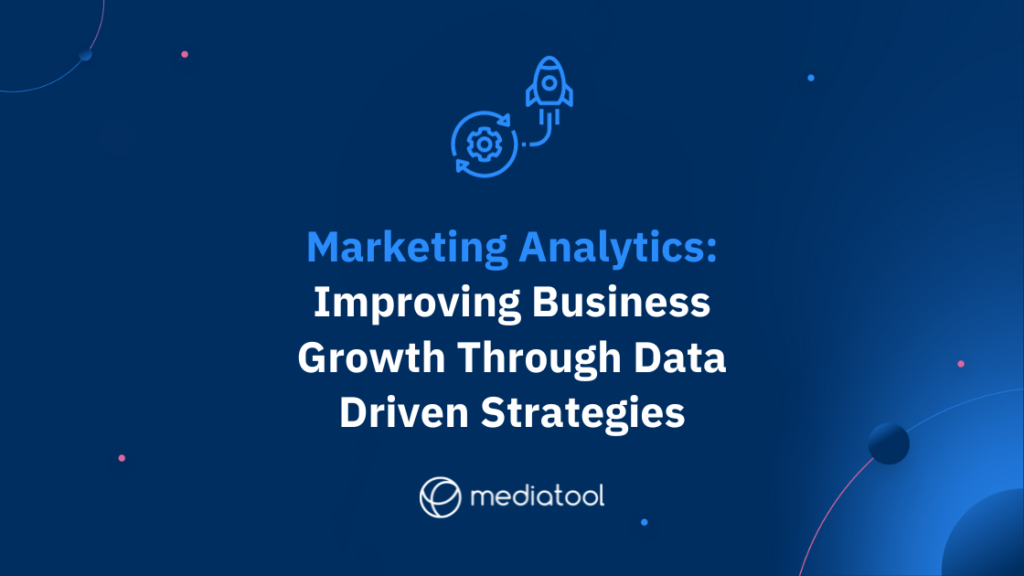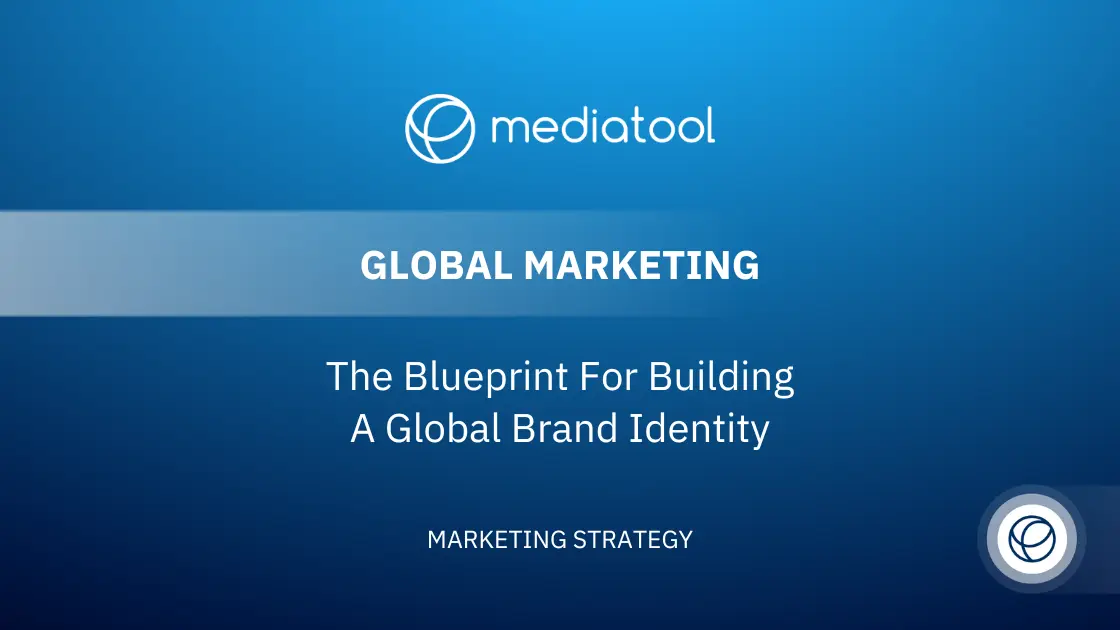Are you facing challenges in understanding where your marketing dollars are going and what returns they’re bringing? Marketing analytics is your answer.
Today, businesses are inundated with data from countless channels – be it social media, emails, online ads, or podcasts. Filtering through this barrage can be overwhelming, leaving many marketers lost.
But imagine having a tool that sorts through this data, offers predictive insights, and uncovers the entire customer journey. Enter Marketing Analytics.
This solution makes sense of the chaos and enabling you to understand and predict marketing trends like never before.
Read on as we see how this game-changing tool can revolutionize your business strategy.

What is Marketing Analytics?
Let’s start basic: At its core, marketing analytics is a method to measure, manage, and analyze all your marketing data to maximize its effectiveness and optimize return on investment (ROI). In other words, it helps businesses understand how their marketing dollars are spent and what they get in return.
Now, marketing has been around since the first caveman decided to trade his rock for two sticks (probably). But in today’s digital age, the game has changed. We’ve moved way past billboards and radio jingles. Today, marketing is spread across a myriad of channels: social media, email, websites, online ads, podcasts – you name it. And with so many channels, comes a tsunami of data.
Marketing analytics collects data from all these channels, making sense of the chaos. By tracking user behaviors, engagement metrics, and more, businesses can answer questions like:
- Which ad campaign has folks rushing to our site?
- Are our social media posts engaging or just a scroll-past?
- Which email subject lines have people clicking faster than a “cat plays piano” video?
However, despite the abundance of data at our fingertips, a surprising statistic reveals that only 53% of marketers regularly use data to guide their marketing decisions. This highlights a significant gap and an opportunity for businesses to leverage analytics more comprehensively to drive their marketing strategies and decisions.
Adding to the complexity, an unsettling 62% of marketers express merely moderate confidence—or even less—in the efficacy of their systems for data, analytics, and insights. This statistic underscores a crucial point: while marketing analytics offers transformative potential, there remains a substantial portion of the marketing community that is yet to fully trust or comprehend the capabilities of their analytics tools.
But that’s not all.
Marketing analytics isn’t just about understanding past behaviors; it’s also predictive. Think of it like a weather forecast for your business. Using past data, it can predict future trends. So, if you ever thought, “If only I knew what the next big thing would be,” this is your answer!
It offers businesses a holistic view. It’s not just about how many likes a post got or how many people visited a website. It’s about understanding the entire customer journey. From that first click on an ad to finally making a purchase, marketing analytics tracks the whole shebang.
Why is Marketing Analytics Important?
Alright, let’s get straight to the point. Imagine you’re managing a new marketing campaign. You have goals you want to reach, but you’re making decisions based solely on intuition. Without the right data and metrics, it’s easy to stray off course, waste resources, or even make costly mistakes. That’s what it’s like to do marketing without analytics. Now, are you ready to understand why using analytics in your marketing efforts is so crucial?
ROI, ROI, ROI!
In the land of businesses and budgets, ROI (Return on Investment) reigns supreme. You’re spending hard-earned money on marketing, so naturally, you’d want to know if it’s making any difference. Marketing analytics is your personal accountant, showcasing where your money’s making the most impact.
Hello, Customer Insights!
Ever wanted a magic mirror to tell you what your customers are thinking? Marketing analytics is that mirror. Dive deep into the data; you’ll uncover golden nuggets about customer behavior, preferences, and habits. No more playing the guessing game!
Optimization Station
It’s not just about putting in more effort; it’s about being clever with how you work. Companies can tweak and adjust their plans by checking out what’s hitting the mark and what’s missing it. Now, if you’re using a bunch of different tools for your marketing analytics—at least five of them—you’re in for a treat. Your marketing efforts are likely to be 39% more effective!
Predict the Future (Sort of)
While marketing analytics might not tell you next week’s lottery numbers, it can forecast trends. Businesses can anticipate customer needs and stay ahead of the curve. So, when a trend hits the mainstream, your brand’s already riding the wave!
Unified View
Marketing nowadays is everywhere – social media, emails, websites, billboards. With analytics, all these channels come together under one roof, providing a unified view of the customer journey and ensuring that every touchpoint is accounted for and optimized. Remarkably, 75% of business leaders affirm the pivotal role of concrete data in fostering quality business conversations, underscoring the power of analytics in shaping strategic dialogue and decision-making across the enterprise.
Reduce Waste
Throwing money into ineffective marketing strategies is like buying a fancy coffee machine and never using it (and we all know someone who does that). With marketing analytics, businesses can pinpoint where they’re wasting resources and redirect them to strategies that resonate.
Stay Agile
In the digital age, trends change faster than you can say “TikTok.” Being agile and adaptive is key. With real-time data at their fingertips, businesses can pivot on the fly, ensuring they’re always relevant and resonating.
Marketing analytics isn’t just a “nice-to-have”; it’s an absolute must. It acts as the navigational system for your enterprise, guiding you with elegance, accuracy, and efficacy through the vast universe of commerce. Now, wouldn’t you want that for your brand?
Using Marketing Analytics to Improve Business Growth

So, you’re on board with the what and the why of marketing analytics. But here’s the million-dollar question: How can this powerhouse tool actually fuel your business’s growth engine? Let’s shift gears and cruise through this avenue of possibilities:
Tailored Customer Experience
With analytics, you can stop treating all your customers as a monolithic block. Dive deep into segments, personalize your offerings, and watch as customer satisfaction (and loyalty!) skyrockets. It’s crucial to get this right, as over 50% of customers won’t hesitate to switch to a competitor following just one unsatisfactory experience.
Budget Allocation
Every penny counts in the business world. Through marketing analytics, you can discover which campaigns are bringing home the bacon and which are… well, just eating your budget. Redirect funds to what works, and watch those growth graphs tick upwards.
Content Optimization
Have you ever poured hours into creating the perfect content only to hear crickets? Analytics can guide content strategies, highlighting what resonates with your audience. Whether it’s blog topics, video themes, or social media posts, you’re now creating content with purpose and impact.
Conversion Pathways
Not all customer journeys are a straight line. Some might zig, zag, take a pit stop, then speed ahead. With analytics, you can map out these pathways, identifying where prospects convert and where they drop off. With this knowledge, you can streamline the journey, making the path from ‘just looking’ to ‘shut up and take my money’ much smoother.
Product Development Insights
Your products or services aren’t set in stone. Through customer behavior analysis, you can gain insights into what features they love, what they’re indifferent to, and what they wish you had. Like a suggestion box that’s always full, guiding your next product iteration.
Enhance Customer Retention
We all know retaining an existing customer is easier (and cheaper) than acquiring a new one. You can fine-tune your strategies by understanding the factors that lead to churn (customers leaving) and those that boost loyalty.
A/B Testing
Want to know if a red ‘BUY’ button works better than a green one? Or if Email Subject A outperforms Subject B? With marketing analytics, you can run A/B tests, allowing data to guide your decisions.
Geographic Insights
If you’re a global (or aspiring global) brand, knowing which regions resonate with which campaigns can be golden. Tailor your strategies based on geographic preferences, and you’re not just speaking to the world; you’re speaking their language.
Using marketing analytics isn’t just about number-crunching. It’s about weaving these numbers into a strategic tapestry, ensuring every thread, every color, and every knot contributes to a masterpiece of growth.
Common Problems that Marketing Analytics can Solve
Buckle up, friend, because we’re about to tackle some common marketing challenges! But don’t worry. With our powerful tool, Marketing Analytics, we’re well-equipped. Let’s explore the problems that have puzzled many marketers and see how a data-driven approach can provide the solutions.
The Mystery of the Silent Campaign
You launch a campaign expecting fireworks, but all you get are silent fizzes. What went wrong? Analytics pulls back the curtain, revealing where the campaign lacked engagement or where the message missed the mark.
Budget Black Holes
Ever felt like you’re pouring money into a marketing pit with no bottom? With analytics, you can spot the campaigns draining your funds without returns.
The Social Media Ghost Town
Are your social media posts echoing back in an empty digital wilderness? Analytics can reveal the best times to post, the content types your audience prefers, and the platforms where they’re most active. No more shouting into the void!
Emails Gone Astray
Sending emails that get buried in inboxes or, worse, the spam folder? Dive into metrics like open rates, click-through rates, and bounce rates. Fine-tune your approach, ensuring your emails don’t just land, but make an impact.
One-hit Wonders
So, a user visited your website…and vanished. Analytics can provide insights into why visitors aren’t converting. Maybe a webpage takes too long to load, or the checkout process is more confusing than a twisty mystery novel.
The Ad Placement Puzzle
Where do you place your ads for maximum visibility and engagement? Instead of playing pin-the-tail-on-the-donkey, let analytics guide your ad placements, ensuring the right eyes see them at the right time.
Disconnected Customer Journeys
Have you ever wondered how a customer moved from seeing an ad to making a purchase? Or why they abandoned their cart? Analytics maps out these journeys, revealing the smooth highways and the bumpy roads in your sales funnel.
Trend-chasing Troubles
Jumped onto a trend too late? Or invested in a fad that fizzled out fast? Predictive analytics can forecast upcoming trends, ensuring you’re not just on the bandwagon, but driving it.
Geo-targeting Goofs
Targeting a global audience without understanding regional preferences? Analytics breaks down data by geography, ensuring your marketing message resonates, whether it’s in Texas or Tokyo.
In the grand scheme of things, consider Marketing Analytics as your versatile toolkit in the complex marketing world. Each challenge presents an opportunity to utilize a specific tool and address it effectively. So, ready to navigate the marketing challenges with some data-driven strategies? You betcha!
How to Choose Marketing Analytics Software

Okay, so you’re convinced, you’re ready to invest in marketing analytics software. But here comes the big question: How do you choose the right one? —so many options, so little time. Let’s break it down.
Ease of Use
You don’t need a Ph.D. in Computer Science to use marketing analytics software. Look for something user-friendly, where pulling reports feels as easy as scrolling through your favorite social media feed. Wouldn’t it be nice if insights were just a click away?
Integration Capabilities
Your analytics software must play well with others in today’s interconnected world. Does it integrate with your CRM? How about your email marketing platform? The last thing you want is a lone wolf that doesn’t communicate with your other systems.
Customization
One size rarely fits all in marketing; opt for software that customizes dashboards, reports, and metrics. After all, you’re the artist of your analytics masterpiece; shouldn’t you pick the colors?
Scalability
Your business is growing, and your software should grow with you. Check if the software can handle more data and additional features as you expand.
Real-Time Reporting
In our fast-paced world, being up-to-date isn’t just nice; it’s essential. How quickly does the software update its data? Can it offer real-time insights? You want to catch trends as they happen, not after they’ve passed.
Multi-Channel Support
As we’ve discussed, marketing is no longer a one-trick pony. Ensure your chosen software can gather data from multiple channels—social media, web traffic, email, and more.
Data Security
With great power (and great data) comes great responsibility. How secure is the software? Check their compliance certifications and data encryption methods. Your data is your treasure; make sure it’s locked up tight.
Cost Factor
Budgets are a reality we can’t ignore. Make sure to align your software choice with your budget constraints. But remember, cheap doesn’t always mean value. Weigh the features against the cost to find that sweet spot.
Customer Support
Sometimes, things go haywire. Servers crash. Data gets jumbled. When that happens, you want a responsive customer support team that treats your crisis as their own. Don’t underestimate the power of a good helpdesk!
User Reviews and Recommendations
Lastly, who better to give you the scoop than folks who’ve used the software? Look for user reviews, ask for recommendations, and, if possible, opt for a trial period. You wouldn’t buy a car without a test drive, would you?
Wrap Up
In an era where the digital landscape is saturated with diverse marketing campaigns, it has become imperative for businesses to harness the potential of their marketing data. This data, when analyzed appropriately, has the potential to reshape how marketing teams approach their overall marketing strategy.
From the moment a campaign is conceptualized to its execution, having a robust marketing analytics solution in place can streamline the process. Through rigorous data analysis, teams can derive valuable insights, ensuring each marketing activity is not only aligned with business objectives but also resonates with its target audience.
Additionally, using advanced analytics tools enables teams to dissect intricate details of their campaigns. Whether it’s understanding user engagement across various marketing channels or predicting trends for future campaigns, these tools offer actionable insights. These insights, rooted in data analytics, empower marketing initiatives by providing a clearer picture of customer behavior and preferences.
One can’t stress enough how marketing analytics helps in bridging the gap between marketing teams and their target audience. With the vast amount of data collected today, including rich customer data, businesses can tailor their messaging, ensuring it’s impactful and relevant. This, in turn, optimizes marketing investments, making sure every dollar spent has a tangible ROI. The precision that comes from analyzing data ensures that every marketing program is geared towards success. With the integration of advanced technologies, such as machine learning, the complexity of understanding marketing performance across different marketing channels becomes a task that’s not just feasible but also efficient.
To sum it up, in the complex realm of modern-day marketing, where the success of your marketing campaigns is determined by how effectively you can harness and analyze data, it’s crucial to have a comprehensive marketing analytics guide. Such a guide offers clarity, helping businesses decipher the maze of information at their fingertips.
From streamlining marketing activities to predicting trends for future initiatives, the art of analysis in marketing analytics proves invaluable. In essence, as businesses venture further into the digital age, the mantra remains clear: to succeed, one must not just gather data but must also master the art of deriving actionable insights from it.





